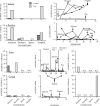Classroom application of a trial-based functional analysis
- PMID: 21541140
- PMCID: PMC3050467
- DOI: 10.1901/jaba.2011.44-19
Classroom application of a trial-based functional analysis
Abstract
We evaluated a trial-based approach to conducting functional analyses in classroom settings. Ten students referred for problem behavior were exposed to a series of assessment trials, which were interspersed among classroom activities throughout the day. Results of these trial-based functional analyses were compared to those of more traditional functional analyses. Outcomes of both assessments showed correspondence in 6 of the 10 cases and partial correspondence in a 7th case. Results of the standard functional analysis suggested reasons for obtained differences in 2 cases of noncorrespondence, which were verified when portions of the trial-based functional analyses were modified and repeated. These results indicate that a trial-based functional analysis may be a viable assessment method when resources needed to conduct a standard functional analysis are unavailable. Implications for classroom-based assessment methodologies and future directions for research are discussed.
Keywords: classroom; functional analysis; trial-based assessment.
Figures


References
-
- Carr J.E, Coriaty S, Dozier C.L. Current issues in the function-based treatment of aberrant behavior in individuals with developmental disabilities. In: Austin A, Carr J.E, editors. Handbook of applied behavior analysis. Reno: Context Press; 2000. pp. 91–112. (Eds.)
-
- Ervin R.A, Radford P.M, Bertsch K, Piper A.L, Ehrhardt K.E, Poling A. A descriptive analysis and critique of the empirical literature on school-based functional assessment. School Psychology Review. 2001;30:193–210.
Publication types
MeSH terms
LinkOut - more resources
Full Text Sources
Medical

